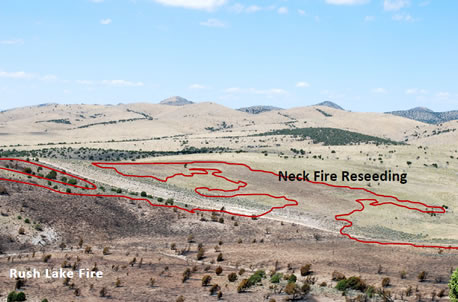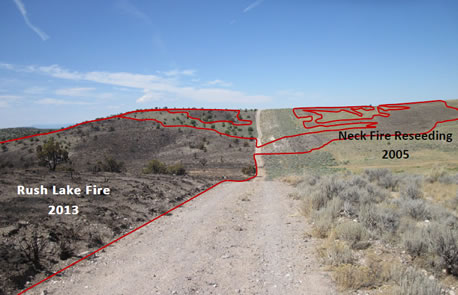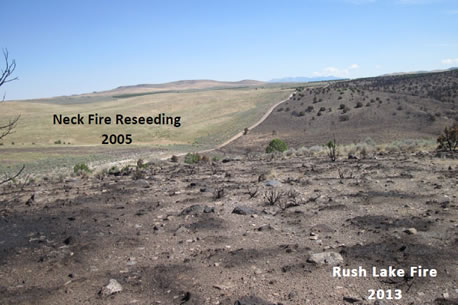National Cohesive Wildland Fire Management Strategy Success Story
After the Fire - Managing Problem Fire Areas is Crucial
Bureau of Land Management, Color Country District, Utah
Cohesive Strategy – Restore and Maintain Landscapes
2013
On July 26, the lightning caused Rush Lake Fire, located approximately 12 Miles north of Cedar City burned 350 acres of land in one of Color Country District’s largest “problem areas” for wildfires. “Wildfires in the Black Mountains and surrounding area account for a large portion of the district’s larger fire suppression operations in recent years,” said Fuels Program Manager Paul Briggs. “The Rush Lake Fire would have likely been much larger if it didn’t burn into a successful post-fire seeding conducted by the Bureau of Land Management,” said Briggs.

The Rush Lake Fire may have been much larger if had not burned into the Neck Fire (2005) post-fire seeding.
After multiple burned area rehabilitation projects in the Black Mountains, land managers are starting to see progress in preventing fires from having catastrophic effects on wildlife and the ecosystem. Many of these fires burn thousands of acres at one time, affecting critical habitat for sage grouse and mule deer, and creating opportunity for erosion and invasive species.
| Year | Wildfire | Acres |
|---|---|---|
| 2013 | Rush Lake | 350 |
| Black Mountain | 4,324 | |
| Gap | 881 | |
| 2012 | Roundabout | 2,458 |
| Baboon | 19,779 | |
| 2011 | Wrangler | 8,455 |
| 2010 | Hot Springs | 329 |
| Badger | 400 | |
| 2009 | Baboon | 200 |
| 2008 | Narrows | 629 |
| 2006 | Badger | 8,000 |
| Pipeline | 200 | |
| 2005 | Neck | 5,000 |
Cheat grass promotes large fire growth and inhibits the establishment of desired vegetation essential to wildlife. As these images indicate, these seeded sites have and continue to pay dividends when seeded with favorable grasses, forbs and shrubs frequently used to rehabilitate burn sites in southern Utah.

The Rush Lake Fire burn area next to the Neck Fire (2005) post-fire seeding.
The Black Mountains are known to be a very lighting prone area and experience more damaging fires than beneficial fires. Without effective post-fire management, this area will continue to be problematic and a significant fire suppression expense for years to come.
Projects adjacent to Rush Lake and Black Mountain wildfires have proven to be valuable investments in 2013 as they have both halted after intercepting previous post-fire seeding projects.

The Rush Lake Fire burn area next to the Neck Fire (2005) post-fire seeding.